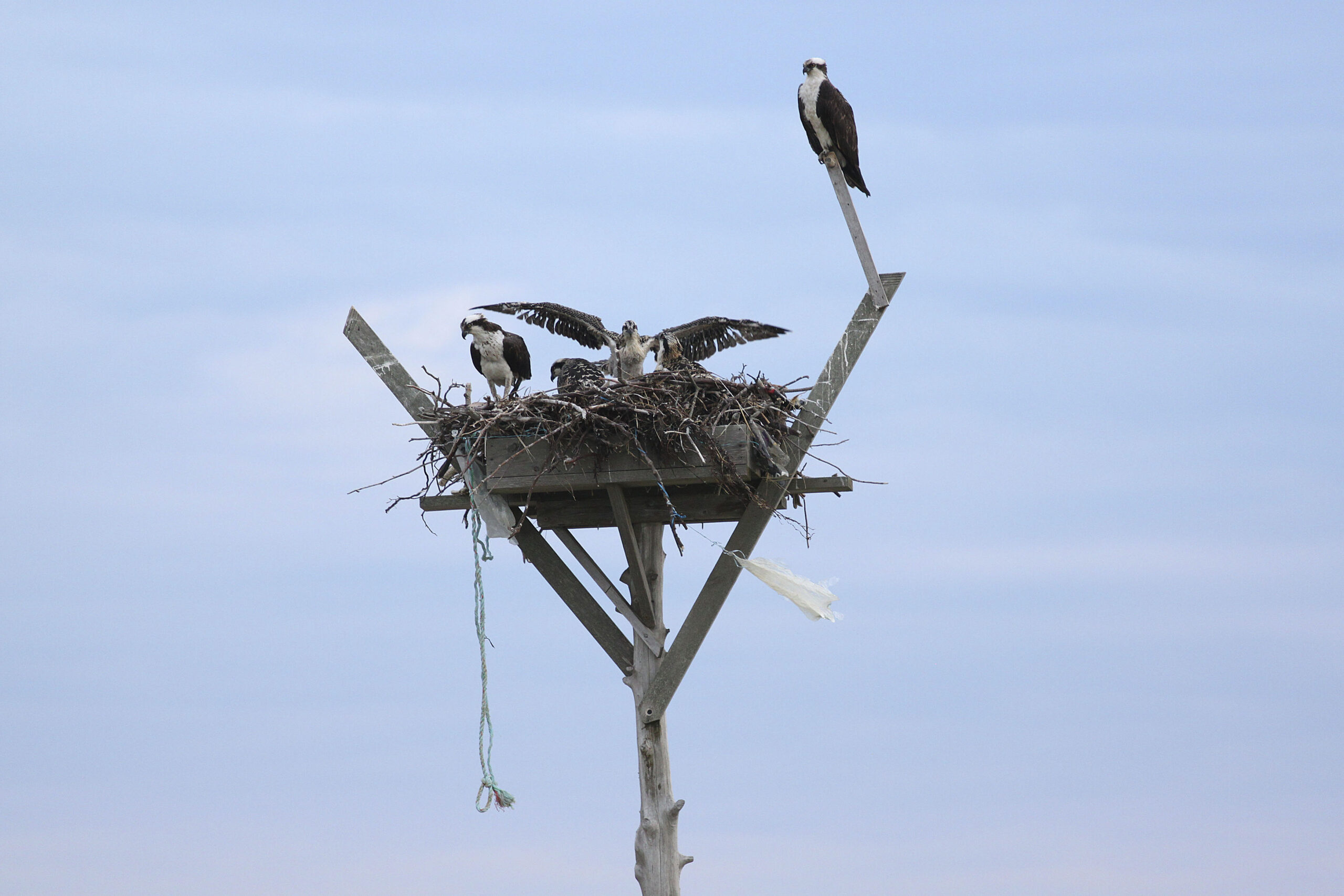
Since the 1970s, the East End’s osprey population has made a remarkable comeback, much in thanks to the efforts of the Group for the East End.
This year, the organization will prioritize public education on the once-endangered raptor and compiled a list of frequently asked questions to start the dialogue on osprey habits and what local residents can do to help.
Do osprey only nest on poles or platforms?
No. When osprey populations declined in the 1970s, poles and platforms were installed to help bring the birds back from the brink of extinction. Ospreys historically nest on trees, rocks, or even right on the beach.
Do East End ospreys still need constructed platforms to survive?
Not presently. Thanks to the exceptional conservation efforts of dedicated individuals and organizations, osprey populations have increased steadily. In fact, many birds are returning to natural nest sites.
Does Group for the East End install nesting platforms?
Group for the East End rarely installs nesting platforms. The Group has shifted its species recovery strategy toward monitoring the regional osprey population. We are also working to reduce conflicts between ospreys and people, encouraging a return to more natural nesting sites and preserving vital nesting habitats.
Can I install an osprey platform on my property?
Sometimes. Some properties may not have suitable habitat for an osprey platform, and installing an osprey pole would not be effective. If your property has suitable habitat for an osprey platform, you can have one installed.
Osprey poles or platforms must be installed by a licensed and insured contractor and in accordance with local building requirements. You can contact Group for the East End at info@eastenedenvironment.org to determine if you have a suitable habitat to install a platform.
Can I remove an osprey nest on my property?
You cannot remove an osprey nest during the breeding season unless approved by the New York State Department of Environmental Conservation (NYSDEC). State law protects osprey and their nests from disturbance or disruption during the breeding season between March 15 to September 1. Outside of the breeding season, when ospreys migrate to their wintering grounds, NYSDEC can authorize nest removal if the nest location is a nuisance or creates a danger to the home.
Can I relocate an osprey nest on my property?
Sometimes. Osprey nests can be relocated to nearby platforms when possible. Their nests cannot be moved during the breeding season without special permits from the NYSDEC. Any nest moved must be placed in an appropriate location to give the birds the best opportunity of breeding success.
I see an osprey nest in danger, what should I do?
Ospreys love to nest on tall objects such as trees and platforms, however, they can also get into trouble on electric or utility poles, chimneys, and stadium lights. If you see a nest that may be in danger, contact Group for the East End or PSEG (if the nest is on a utility pole).
What do I do if I see an osprey in danger?
If you spot an osprey that appears to be in danger, contact your local wildlife rehabilitator right away, such as the Evelyn Alexander Wildlife Rescue Center at 631-728-4200, or the emergency line at 631-728-9453.
How is Group for the East End currently protecting ospreys?
The Group and PSEG are working to identify, map and install appropriate mitigation measures on hundreds of utility poles that pose a hazard to nesting birds. PSEG has used data provided by the Group to install hundreds of deterrents and relocate nests in dangerous locations. The ospreys will be returning to a safer breeding ground this season.
I am concerned about the stability of an osprey nest, what should I do?
Osprey nests, like any structures, may deteriorate or fall apart over time. However, ospreys are skilled carpenters and will usually rebuild or secure a nest when they return for the breeding season. If you are concerned about the stability of an osprey platform in one of the five East End Towns, contact Group for the East End.
How can I prevent ospreys from nesting on my home, dock, or other structures that may be both dangerous to the birds or a nuisance?
Ospreys can be tenacious once they find a nest site they like. It can be extremely difficult to deter the birds from nesting in these locations, even if they are inconvenient or dangerous. The best strategy is to make the nesting site unattractive or difficult to build on.
You can do this by using flagging/streamers to create a colorful movement around the nesting site, making it less attractive. Physical deterrents can be used to create a smooth, steep, or uneven surface. Large plastic cones, uneven crates and slippery plastic pails all make for good deterrents, too. Be aware that spikes typically used to deter pigeons can serve as a good foundation for osprey nests.
Decoys, ranging from ground predators — like a fox or coyote — or large raptors, such as a red-tailed hawks, can deter ospreys from nesting in high risk or potential conflict areas. Although success rates vary, one of the most effective decoys used to deter osprey is a bald eagle, which is a natural and aggressive competitor with osprey. Be sure to install these decoys before March 15, when the breeding season begins.
Do not use any material that could cause entanglement, such as fishing line, wire, any form of twine, fishing nets, chicken wire, or bungee cords. Ospreys and other birds can become entangled and sustain life-threatening injuries.